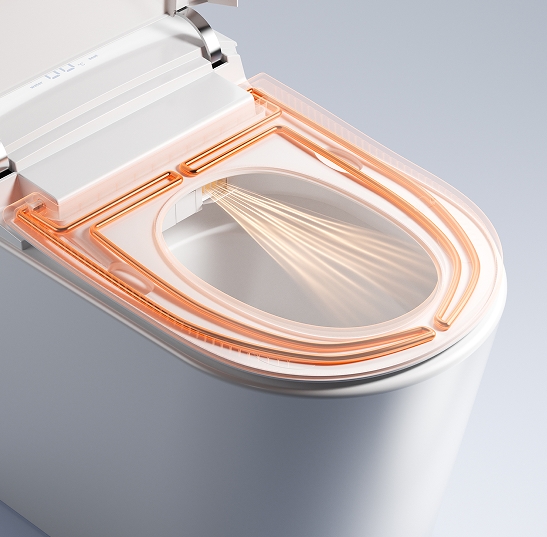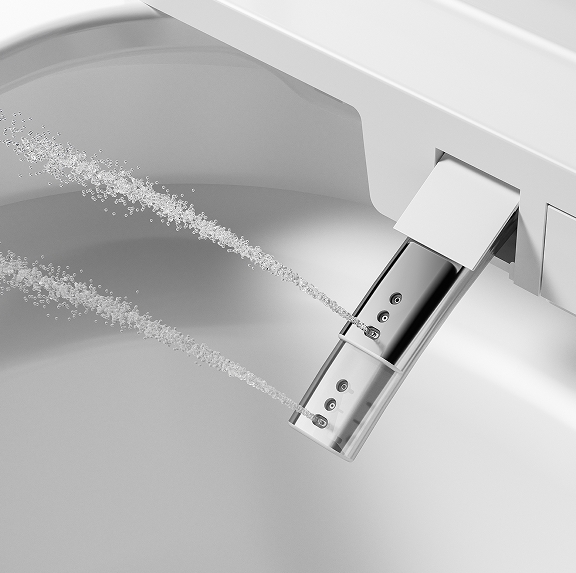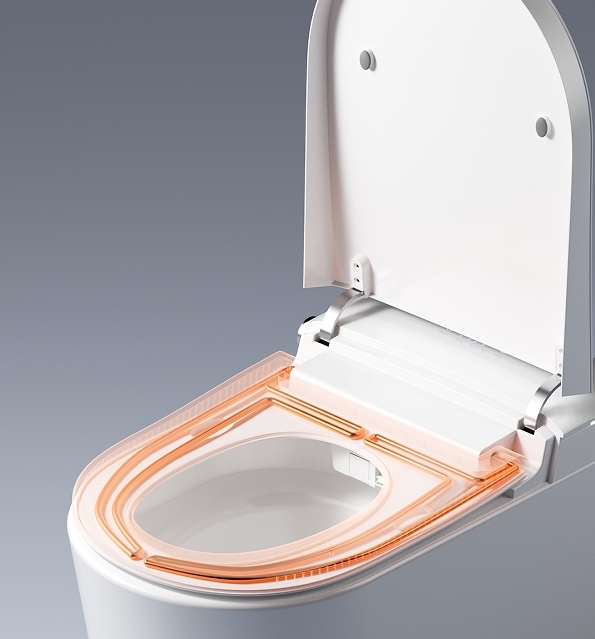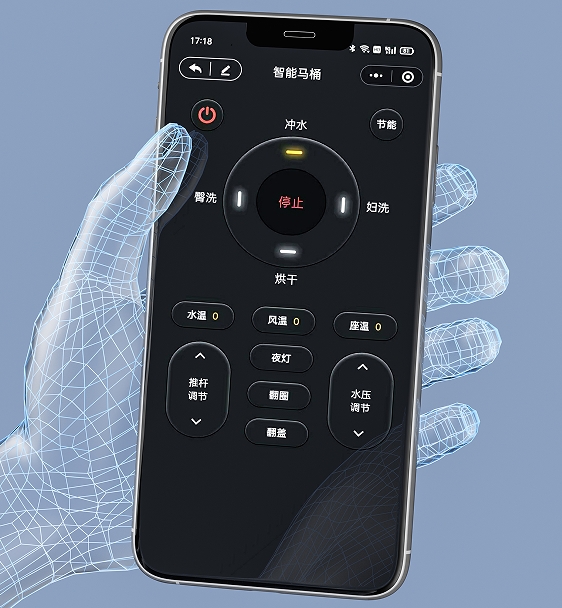In the domain of modern bathroom innovations, wall hung smart toilets stand out with their sophisticated blend of technology and design. As homeowners and designers seek to enhance both functionality and aesthetics, identifying the top features becomes essential. From advanced bidet systems promoting superior hygiene to energy-efficient mechanisms supporting sustainable living, the choice of features can transform everyday routines. Considerations extend to comfort aspects like heated seats and adjustable water temperatures, paired with convenience offered by remote control operations. Yet, what truly defines the ideal smart toilet may surprise you, inviting further exploration of this intriguing subject.
In contemporary wall hung smart toilets, advanced bidet functions represent a significant leap in personal hygiene technology. Originating in 18th-century France, the bidet has evolved from a simplistic basin to a sophisticated device embedded in modern toilets. This evolution underscores the bidet's history as a proof of human ingenuity in the pursuit of hygiene.
Today's advanced bidet functions in smart toilets offer an array of customizable features, including adjustable water pressure, temperature control, and oscillating spray patterns. These functions provide a personalized cleansing experience, meeting the diverse needs and preferences of users.
The integration of advanced bidet functions into smart toilets yields numerous bidet benefits, enhancing both hygiene and user comfort. By utilizing water for cleaning, these systems reduce the reliance on toilet paper, thereby minimizing environmental impact and promoting sustainability. Furthermore, the precision of water-based cleansing offers superior hygiene compared to traditional methods.
For individuals seeking control over their personal hygiene routines, smart toilet bidets present an unrivaled solution. Their ergonomic design and intuitive controls guarantee ease of use, while their technological sophistication aligns with the demands of modern living. Overall, advanced bidet functions redefine sanitation standards, elevating the bathroom experience.

Download product catalog
Automatic flushing systems in wall hung smart toilets leverage sensor-based flush technology, greatly enhancing water efficiency and promoting ideal hygiene standards.
By employing precise sensors, these systems guarantee that flushing occurs only when necessary, reducing water waste and contributing to sustainability efforts.
Furthermore, the touchless operation provides a convenience boost, minimizing user interaction and the potential spread of germs, thereby elevating overall hygiene levels in modern bathroom environments.
Sensor-based flush technology represents a significant advancement in the domain of bathroom automation, providing an efficient and hygienic solution for modern smart toilets. At the core of this innovation are smart sensors, which detect user presence and, based on pre-set user preferences, automatically initiate the flushing process. This not only enhances convenience by eliminating the need for manual flushing but also guarantees a more sanitary environment by minimizing contact with toilet surfaces.
Smart sensors utilize infrared or capacitive sensing technologies to accurately gauge when a user has vacated the toilet. This detection mechanism is fine-tuned to accommodate various user preferences, allowing for customization that suits individual needs and habits. Such personalization guarantees that the technology aligns seamlessly with user expectations, offering a tailored bathroom experience.
| Feature | Benefit | Example Technology |
| Smart Sensors | Contactless operation | Infrared, Capacitive |
| User Preferences | Customizable flush settings | Personalized programming |
| Automatic Flush | Enhanced hygiene and efficiency | Presence detection |
Furthermore, these systems are designed to be fail-safe, incorporating redundancy to guarantee reliability. By integrating sensor-based flush technology, wall hung smart toilets provide a sophisticated balance of hygiene, convenience, and user-centric design.
The integration of water-saving mechanisms in wall hung smart toilets signifies a pivotal leap towards sustainable bathroom technology. These advanced systems efficiently combine cutting-edge design with eco friendly features, ensuring ideal water conservation.
Automatic flushing, a key component of such toilets, utilizes precise sensors to determine the necessary water volume for each flush, thereby minimizing wastage. This method stands in stark contrast to traditional toilets, which often flush a fixed amount of water irrespective of necessity.
wall hung smart toilets are designed to meet stringent water conservation standards, often featuring dual-flush systems that provide users with the option to select between a full or reduced flush. This capability not only conserves water but also aligns with environmental goals and regulations, such as those outlined by the WaterSense program in the United States.
By prioritizing eco friendly design, these smart toilets considerably reduce household water consumption without compromising performance.
Furthermore, the integration of real-time monitoring systems enables users to track water usage, further enhancing control over consumption. Such innovations are not only a response to growing environmental concerns but also reflect an increasing demand for intelligent, sustainable solutions in modern bathroom fittings.
Seamlessly integrating advanced technology with everyday convenience, wall hung smart toilets elevate hygiene standards through their automatic flushing systems. This innovation guarantees a touchless operation, effectively minimizing contact with surfaces prone to harboring bacteria and pathogens. By employing sensors that detect user presence and departure, these systems initiate a precise flush, maintaining ideal cleanliness without manual intervention.
The automatic flushing mechanism contributes greatly to odor control, an essential aspect in enhancing bathroom hygiene. By guaranteeing immediate waste removal, the system prevents the accumulation of odors, promoting a fresh and sanitary environment. In addition, the integration of deodorizing elements within the flushing system guarantees that any residual scents are neutralized, further elevating the user experience.
From a technical perspective, the automatic flushing systems in wall hung smart toilets are designed for efficiency and reliability. Advanced algorithms govern the flushing process, calibrating the volume of water used to match the nature of the waste, thereby maximizing resource use while guaranteeing thorough cleansing.
For users prioritizing control and precision, these features deliver a sophisticated balance of hygiene and convenience, setting a new standard in modern bathroom technology.

Download product catalog
Heated seats in wall hung smart toilets represent a significant advancement in user comfort and technology integration. These features enhance the experience by providing warmth, especially in colder climates, which elevates the overall user interaction with the toilet system.
The integration of heated seats within the wall hung design maintains the sleek toilet aesthetics that modern consumers demand, without compromising space efficiency. The seamless incorporation of heating elements within the seat guarantees that the visual appeal remains uncluttered, aligning with contemporary bathroom designs that prioritize minimalism.
From an installation perspective, heated seats require careful consideration of the electrical requirements, as they must be connected to a power source. This necessitates a strategic approach to installation requirements, guaranteeing that the necessary wiring does not interfere with the structural integrity of the wall or the aesthetic appeal.
Skilled installation professionals must verify compliance with electrical safety standards while preserving the clean lines and unobtrusiveness characteristic of wall hung systems.
For consumers seeking advanced customization and control, heated seats offer variable temperature settings. This feature allows users to adjust the warmth to their preference, guaranteeing a personalized comfort experience.
Consequently, investing in heated seats not only enhances comfort but also aligns with the desire for modern, efficient bathroom solutions.

Download product catalog
The integration of adjustable water temperature in wall hung smart toilets offers enhanced personalized comfort settings, catering to individual user preferences and varying environmental conditions.
This feature not only guarantees ideal user experience but also contributes to energy efficiency by minimizing unnecessary water heating.
Additionally, the capability for seasonal temperature adjustments allows for seamless adaptation to climate changes, maintaining consistent comfort throughout the year.
Many modern wall hung smart toilets are equipped with customizable features that enhance user comfort, particularly through adjustable water temperature settings. This feature offers an unparalleled level of personal hygiene control, allowing users to fine-tune the water temperature to their preference.
For those seeking smart home integration, this function can be seamlessly controlled via a user-friendly interface, providing intuitive customization options. By leveraging advanced technologies, users gain the ability to adjust settings effortlessly, ensuring maximum comfort with each use.
The precision of adjustable water temperature settings is achieved through sophisticated thermostatic controls, which maintain consistent temperatures, eliminating the shock of sudden temperature fluctuations. This feature is particularly beneficial in households with multiple users, as it allows for individualized profiles that retain specific temperature preferences.
The integration of these settings into a smart home ecosystem enhances the overall experience, enabling remote operation and scheduling through smart devices.
Furthermore, the user-friendly interface simplifies the process of setting and saving preferences, ensuring that even the most technologically averse individuals can enjoy the benefits of this feature.
Ultimately, the incorporation of adjustable water temperature settings in wall hung smart toilets exemplifies the fusion of technology and personalized comfort, catering to those with discerning tastes for control and customization.
wall hung smart toilets, equipped with adjustable water temperature features, contribute considerably to energy efficiency in modern households. The integration of this functionality allows users to precisely control the water temperature, reducing unnecessary energy consumption. By tailoring the water temperature to specific needs, such systems minimize the demand on heating elements, ensuring only the necessary amount of energy is used. This is a marked improvement over conventional toilets that lack such precision, thereby promoting a more efficient use of resources.
The use of sustainable materials and eco-friendly design in these smart toilets further enhances their energy efficiency. Materials selected for their thermal retention properties reduce the energy required to maintain desired temperatures, thereby enhancing overall system performance. Additionally, the eco-friendly design not only supports energy efficiency but also contributes to water conservation by improving flush volumes in conjunction with temperature management.
Moreover, these systems often include advanced sensors and programmable settings that allow for automatic adjustment, preventing energy wastage and ensuring peak operation. By leveraging these technologies, homeowners can achieve significant reductions in both energy use and utility costs, making wall hung smart toilets a prudent choice for eco-conscious individuals seeking to control their environmental impact.
Adjustable water temperature in smart toilets allows for nuanced seasonal temperature adjustments, offering users enhanced comfort and efficiency. This feature is essential for maintaining an ideal user experience throughout varying climatic conditions.
During colder months, the ability to increase water temperature guarantees warmth and comfort, while in warmer seasons, a cooler setting can enhance refreshment. Such adaptability is achieved through advanced temperature regulation systems that precisely control water temperatures to suit user preferences.
Technical specifications often include a range of temperature settings, allowing for fine-tuned adjustments. This flexibility is vital for users who prioritize control over their personal hygiene experience.
The integration of sensors and algorithms enables the smart toilet to make real-time adjustments based on ambient room temperatures, assuring consistent performance.
Seasonal maintenance is simplified as these systems are designed for minimal intervention. Regular checks can confirm that temperature regulation components are functioning effectively, thereby extending the lifespan of the device.
This feature not only enhances user satisfaction but also contributes to energy efficiency, as the system adjusts temperature outputs according to environmental demands.
As a result, the inclusion of adjustable water temperature in smart toilets represents a significant advancement in bathroom technology, aligning with user preferences for comfort and control.
In recent years, advancements in smart toilet technology have led to significant improvements in energy efficiency, which is a critical component in reducing household energy consumption. These innovations focus on the integration of smart design and intuitive user interfaces that empower users to manage their energy usage effectively.
By incorporating sensors and adaptive systems, wall hung smart toilets can optimize water and electricity consumption based on user habits, ensuring that resources are used only when necessary.
The smart design of these toilets often includes features such as automatic flushing mechanisms, which adjust water usage to the minimum required, reducing waste. Additionally, the user interface plays a pivotal role in energy efficiency by providing users with real-time data on their water and energy consumption. This information allows users to make informed decisions and adjustments to their usage patterns, further enhancing efficiency.
Moreover, many smart toilets are equipped with energy-saving modes that can be activated during low-usage periods, minimizing power consumption. The integration of energy-efficient heating elements for seat warming and water temperature control further contributes to overall sustainability.
Collectively, these features represent a sophisticated approach to energy management, aligning with the modern consumer's desire for both convenience and environmental responsibility.
Leveraging remote control capabilities, modern smart toilets bring unprecedented convenience and customization to bathroom technology. With the integration of remote access and app integration, users can command a variety of functions from virtually any location. This technology enables users to adjust settings such as water temperature, pressure, and even the angle of the water spray, providing a personalized experience tailored to individual preferences.
Remote access allows for the seamless management of these features through a dedicated mobile application. App integration plays an essential role in ensuring that the user interface is intuitive and accessible, facilitating ease of use for both tech-savvy individuals and those less familiar with digital interfaces. Users can pre-program settings, schedule operations, and receive notifications about maintenance needs directly on their devices.
The convenience of remote control features extends beyond individual customization. For households with multiple users, different profiles can be established, ensuring that each member enjoys a tailored experience without the need for manual readjustments.
Additionally, remote diagnostics are facilitated, allowing for timely identification and resolution of technical issues, minimizing downtime. Consequently, remote control features not only enhance user experience but also contribute to the efficient management of smart toilet functionalities.

Download product catalog
A hallmark feature of advanced wall hung smart toilets is the self-cleaning system, which greatly enhances hygiene and maintenance efficiency. This cutting-edge cleaning technology utilizes a combination of automated processes and specialized coatings to minimize user intervention and enhance smart toilet maintenance. The system typically includes mechanisms such as electrolyzed water and UV light sterilization, which work synergistically to eliminate bacteria and reduce stains, consequently ensuring a consistently pristine toilet bowl.
In terms of operational dynamics, the self-cleaning system activates automatically before and after each use, thereby maintaining ideal sanitary conditions. The sophisticated design incorporates sensors that detect usage patterns, allowing the system to perform periodic cleaning cycles without user input. This proactive approach not only reduces the frequency of manual cleaning but also extends the lifespan of the toilet by preventing lime scale build-up and corrosion.
Furthermore, the integration of advanced cleaning technology in smart toilets offers an eco-friendly solution, often utilizing minimal water and energy resources. By embracing these features, users can experience both enhanced convenience and a significant reduction in maintenance demands.
Consequently, the self-cleaning system represents a pivotal evolution in toilet hygiene, aligning with modern expectations for efficiency and sustainability.
Smart home integration is a key consideration for those seeking control over their environment. Ensuring toilet compatibility with existing systems is essential. Many smart toilets offer seamless integration, allowing users to manage features through centralized smart home platforms efficiently.
In the domain of wall hung smart toilets, where precision is king, understanding weight specifications and load limits is essential. Typically, these toilets support up to 500 pounds, ensuring reliability and safety for diverse user requirements.
The installation process for a wall hung smart toilet can present significant installation challenges, primarily due to plumbing and structural requirements. Engaging professional assistance is advisable to guarantee precise alignment and integration, minimizing potential complications and ensuring ideal functionality.
According to recent studies, 67% of parents prioritize safety features in home installations. wall hung smart toilets often include a child lock mechanism and adjustable height settings, enhancing both functionality and security for households with young children.
Maintenance of a wall hung smart toilet involves regular cleaning to prevent buildup and guarantee sanitation. Implementing effective cleaning tips and proactively addressing troubleshooting issues will enhance performance, extend longevity, and reduce potential operational disruptions, ensuring ideal functionality.
In examining the essential features of wall hung smart toilets, one must consider how these innovations enhance both functionality and sustainability. Advanced bidet functions, automatic flushing, and adjustable water temperatures contribute to superior hygiene and user comfort. Heated seats and remote control features further elevate the user experience. Additionally, energy-efficient and self-cleaning systems align with broader environmental objectives. How does this amalgamation of technology and eco-consciousness redefine modern bathroom standards? The answer lies in the seamless integration of these sophisticated features.